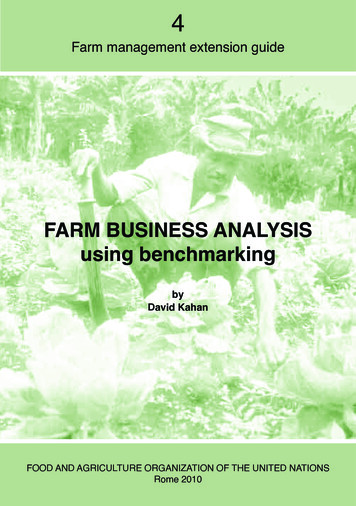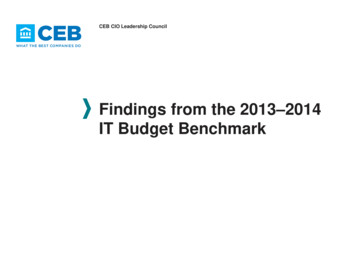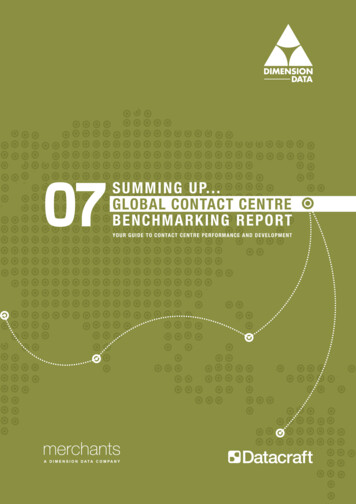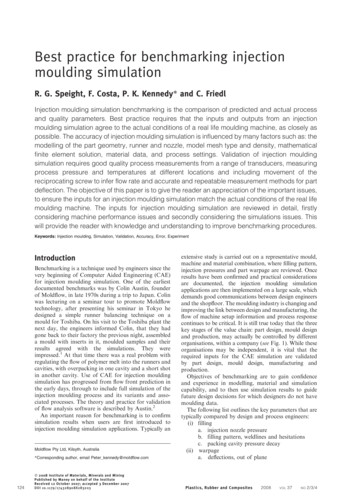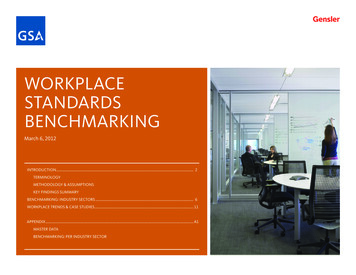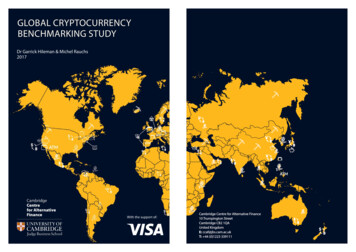
Transcription
2015Health Care Benefits Benchmarking SurveyEighth Edition8575 164th Avenue NE, Suite 100Redmond, WA 98052877-210-6563http://salary-surveys@erieri.com
Data Effective Date: January 1, 2015Organizations Represented: 101Number of Employees at Participating Organizations: 70,113Copyright 2015 All rights reservedThis report utilizes technologies and data as part of the ERI Economic Research Institute, Inc. (“ERI”)family of salary surveys including data from PAQ Services. ERI’s intellectual property rights include PatentNos. 6,862,596 and 7,647,322, “System and method for retrieving and displaying data, such as economicdata relating to salaries, cost of living and employee benefits” that are leased from ERI and used by SurveyAffiliates.2ERI Salary Surveys 2015
3ERI Salary Surveys 2015
2015 Health Care Benefits Benchmarking SurveyEighth EditionOverviewSURVEY SCOPE/METHODOLOGYERI Economic Research Institute and ERI Salary Surveys are the sponsors for the 2015 Health Care BenefitsBenchmarking Survey. This eighth edition of the survey is offered through ERI Salary Surveys.Questionnaires were designed and distributed for this eighth edition of the Health Care BenefitsBenchmarking Survey in October 2014. Participation was solicited from employers in the public, private,and non-profit sectors, as well as government entities in the United States. Data input was collected in theperiod from October 1, 2014, to February 15, 2015. The requested effective date of benefits data wasJanuary 1, 2015.One hundred one (101) U.S. organizations contributed data to the survey. Characteristics of participantsvary greatly and are illustrated in the “Characteristics of Participating Organizations” section of thesurvey. Eighteen (18) industry groups are represented in the United States.In accordance with our objective to publish only the most accurate and representative informationpossible, each data submission was thoroughly reviewed by our experienced research staff before it wasincluded in the survey. Areas in question were reconciled with participants before inclusion.The data received have been analyzed to the maximum degree possible. Because of this, some smallsample sizes are displayed for some organization types and descriptions. Data cuts are provided byorganization sector, industry group, organization size (by number of employees), and geographic region.Please note that percentages in tables that are intended to represent the entire sample may not total100% due to rounding. The total number of responses may also vary from section to section since allrespondents do not necessarily provide input on each question asked and some questions may not beapplicable to some organizations. Specific data may not be reported in this reference report whereinsufficient data was received to questions presented in the survey questionnaire.Although questions were asked in the survey questionnaire regarding health care benefits for retirees andpart-time employees, no contribution information or costs were requested. As such, employee andorganization contributions reported in this survey are reported for full-time, active employees only. Parttime employees and retirees were assumed not to be covered and were excluded from the calculations.4ERI Salary Surveys 2015
Geographic regions for the United States in this survey are defined as:Northeast Region: Connecticut, Massachusetts, Maine, New Hampshire, New Jersey, New York,Pennsylvania, Rhode Island, Vermont, Delaware, MarylandNorth Central Region: Iowa, Kansas, Minnesota, Missouri, Nebraska, North Dakota, SouthDakota, Wisconsin, Ohio, Indiana, Illinois, Michigan, Wyoming, Idaho, MontanaSouth Central Region: Oklahoma, Texas, New Mexico, Arkansas, Louisiana, Colorado, Utah,ArizonaSoutheast Region: Alabama, Florida, Georgia, Kentucky, Mississippi, North Carolina, SouthCarolina, Tennessee, Virginia, West Virginia, District of ColumbiaWest Coast Region: Alaska, California, Hawaii, Oregon, Washington, NevadaA companion benefit report for nonprofit organizations covering health care data, general benefitpractices, medical insurance, dental insurance, vision insurance, life insurance, disability insurance,retirement plan practices, paid leave, and executive perquisites is also sponsored by ERI Salary Surveysand may be purchased online at www.salary-surveys.erieri.com. The 2015 Benefits in NonprofitOrganizations Survey report will be released on July 1, 2015.ERI Economic Research Institute and ERI Salary Surveys wish to express sincere appreciation for datacontributions made by numerous participating organizations. Their active participation was indispensablein making this reference report an accurate representation of employee health care benefits programseffective as of January 1, 2015.This survey report was prepared by Debbie Lambert, CCP, CBP, GRP, Managing Director, ERI SalarySurveys. The 2015 Health Care Benefits Benchmarking Survey was released on April 2, 2015.5ERI Salary Surveys 2015
EXECUTIVE SUMMARYEmployers are now able to offer a wide range of benefit plans to employees. They can workwith an insurance broker or other benefits profe ssional to select health insurance programsthat meet the needs of employees or they may provide benefit options through a privateinsurance exchange. The selection of an appropriate health plan can be a confusing and time consuming process for both the employer and the employee. Choosing a plan with the lowestpremium often leads to dissatisfaction once out -of-pocket costs are realized. As a result, it isimportant to consider the value of the plan, not just of the plan’s costs, but also its coverage,out-of-pocket expenses, and comparison to other plans.Government-regulated insurance exchange plans are vulnerable to cost increases , just likeemployer-sponsored health plans. Premiums in 2015 for the most popular types of plans in thehealth insurance exchange increased an average of five percent (5%) in the thirty-five (35)states where the federal government is running the health insurance exchanges. Theadministration recommends that consumers who are currently enrolled in these healthinsurance exchanges can mitigate the financial consequences if they are willing to “shoparound” which can be time-consuming and confusing.Despite the rollout of government-regulated insurance exchanges, employer-offered plans arestill the most cost-effective option for employees. The majority of executives continue tobelieve that maintaining an attractive health care plan is critical for attracting and maintainingquality employees. While it would be easy to just compare the cost of paying penalties for notoffering coverage with the cost of health coverage, there would also be indirect costs thatmust be considered such as higher turnover, negative morale, inability to attract talent, andeven additional compensation that may be required to make up for lost health covera ge.Making decisions about health coverage to comply with health care reform involves manyvariables. Until now, many employers’ primary health care strategy has been focused oneasing the year-to-year cost trend. Under the Affordable Care Act (ACA), employers will besubject to a 40 percent excise tax on the value of health insurance benefits above a certainamount beginning in 2018. With these new layers of costs to come, employers are now facedwith more decisions that demand actively managing risk.Health insurance consistently consumes a bigger share of employer costs. Because of this,employers will have to continue to reduce costs by reducing the level of benefits offered or byshifting additional costs to employees. In fact, despite a slowdown in the growth of grouphealth plan premiums, higher deductibles and higher out -of-pocket maximums have clearlyshifted more costs to employees.Another approach taken by many employers is to move to less costly options such as a HighDeductible Health Plan coupled with a Health Savings Account instead of the more traditionalmedical plans. High deductible plans carry lower premiums and shift more medical costs toemployees.This Executive Summary presents selected findings based on this year’s survey. Some trendinformation is provided but trends can be influenced by the mix of survey participants fromyear to year. This report is offered on an annual basis so that trends may be identified, aspossible. Annual participation is encouraged.6ERI Salary Surveys 2015
One hundred one (101) data submissions representing 70,113 employees were received fromparticipants in this survey. Data for two hundred twenty-five (225) medical plans in the UnitedStates and one hundred nineteen (119) dental plans were reported. There are 61,770 enrolledemployees in the U.S. medical plans reported and 55,138 enrolled employees in the dentalplans reported.Representation by region in the United States is as follows: Northeast – 19% North Central – 21% Southeast – 19% South Central – 8% West Coast – 33%Types of medical plans offered in the United States are as follows: Preferred Provider Organization (PPO) – 47% Health Maintenance Organization (HMO) – 28% Point of Service (POS) – 4% Exclusive Provider Organization (EPO) – 3% Indemnity – 0% High Deductible Health Plan (HDHP) – 18%Types of dental plans offered in the United States are as follows: Dental Preferred Provider Organization (DPPO) – 73% Dental Health Maintenance Organization (DHMO) – 19% Dental Point of Service (DPOS) – 3% Dental Indemnity – 4% Dental Discount – 1%In this year’s survey, the average deductible reported in a HDHP/HSA arrangement was 2,162, up slightly from 2,087 in 2014 and 2,048 in 2013. The practice of offering highdeductible health plans has grown significantly over the last fe w years and is expected tocontinue to grow.Other employers are just reducing benefit levels overall by increasing employee contributions,deductibles, co-payments, coinsurance, and out-of-pocket maximums. A new trend surfaced in2012 when several organizations reported a deductible for prescription drugs in addition tothe standard medical deductible. In 2015, only one (1) participating organization reported aseparate prescription drug deductible.This year’s participants reported using the following other cost-saving measures: 56% increased employee contribution to premium7ERI Salary Surveys 2015
29% increased prescription co-payment or coinsurance amounts 29% increased medical co-payment or coinsurance amounts 30% increased deductible amounts 24% increased out-of-pocket maximum amounts 15% changed the drug formulary 18% moved to self-insuranceCost management strategies such as disease management, health promotion, and wellnessprograms are being used by many employers to counter increasing health costs. In the 201 5survey, twenty-four percent (24%) of participating organizations reported their plans asconsumer-directed health plans. Consumer-directed health plans are plans that attempt tocontain medical benefits costs by empowering consumers to make informed choices regard ingthe quality and efficiency of their health care. In addition to the consumer -directed healthplan effort, thirty-three percent (33%) of respondents report introducing new healthpromotion and wellness programs. (This may possibly be the result of the A CA-allowed higherfinancial incentives and the 2018 excise tax.) Another twenty-three percent (23%) ofrespondents report having introduced a disease management program this year. Theeffectiveness of these strategies is still uncertain, however. Most empl oyers recognize thatknowledge of the marketplace is powerful, and benchmarking one’s own health plan costs andpractices with other employers in the external marketplace is the first step in evaluating theeffectiveness of current and future benefit chang es and strategies. Benchmarking employerprovided employee health care benefits is the focus of this survey report. By providing timelyand accurate measurement of health care plan costs, we hope that this report will serve as avaluable reference that may be used when considering plans, changes, and strategies foreffective benefits management.MEDICAL BENEFITSAll but one (1) of the one-hundred one (101) survey respondents offer at least one medicalplan to full-time employees, with Preferred Provider Organization (PPO) plans the mostcommon among all of the four (4) organization sectors surveyed. All plans reported byrespondents who offer medical benefits offer a pharmacy prescription drug plan but eight (8)plans do not offer a mail-order prescription drug plan.Twenty-eight percent (28%) of respondents offer only one (1) medical plan to employees,thirty-six percent (36%) offer two (2) medical plans, twenty-three percent (23%) offer three(3) medical plans, nine percent (9%) offer four (4) medical plans, and four percent (4%) offerfive (5) medical plans to full-time employees. Fifty-three percent (53%) of this year’srespondents offer an opt-out for medical and twenty-eight percent (28%) of thoserespondents offering an opt-out reimburse for opting-out.Preferred Provider Organizations (PPO) continue to dominate the market, enrolling sixty-onepercent (61%) of covered employees in the United States. The percentage of employeescovered in other plan types are fourteen percent (14%) of enrollees in Health MaintenanceOrganization (HMO) plans and two percent (2%) in Point of Service (POS) plans. Six percent(6%) participation was reported in Exclusive Provider (EPO) plans , down from fifteen percent(15%) in 2014. Eighteen percent (18%) participation was reported in a High Deductible HealthPlan (HDHP) combined with a Health Savings Account versus fifteen percent (15%) in 2014,and no participation in Indemnity plans was reported.8ERI Salary Surveys 2015
Preferred Provider Organization (PPO) plans are the most prevalent type of p rimary medicalplan with forty-nine percent (49%) of the total response. Health Maintenance Organization(HMO) plans are the second most common type of benefits delivery with twenty -sevenpercent (27%) of the response. In 2015, High Deductible Health Plans (HDHP) combined with aHealth Savings Account ranked third for the third consecutive year as the most prevalent typeof primary medical plan with seventeen percent (17%) of the response. The average monthlyemployee cost for Preferred Provider Organizatio n (PPO) plans for employee-only coverage is 159.94, up 31% from 122.32 in 2014. The average monthly employer cost for PreferredProvider Organization (PPO) plans for employee-only coverage is 434.06, down 6% from 460.42 from 2014. The employer cost for employee-only coverage for PPO plans equalsseventy-three percent (73%) of the total premium cost reported.It continues to be common to see eligibility requirements for employer -sponsored health careplans as immediate or upon completion of one (1) mont h of service. Eighty-four percent (84%)of respondents report that executives become eligible for health care benefits in one (1)month or less. Seventy-nine percent (79%) of respondents report that exempt employees areeligible following completion of one (1) month or less. Seventy-seven percent (77%) ofrespondents report that non-exempt employees are eligible following completion of one (1)month or less.Employer-sponsored medical benefits for retirees continue to decline. Only fifteen percent(15%) of responding organizations offer medical benefits to retirees . Employers are far morelikely to offer health care benefits to part-time employees than retirees but even this practiceis becoming less common. Thirty percent (30%) of respondents offer medical benefits to parttime employees. Industry groups most likely to offer part -time medical and/or dental benefitsare organizations in health care, nonprofit services, and for profit services.For actual details and costs, please see the survey report.GENERAL FEATURES OF MEDICALThe majority of responding organizations provide some form of wellness and/or diseasemanagement programs to participants. Seventy-six percent (76%) of respondents provide anEmployee Assistance Plan (EAP) while eighty-one percent (81%) offer alcohol/substance abuseservices provisions. Fifty-nine percent (59%) of respondents offer medical benefits todomestic partners.Twenty-eight percent (28%) of this year’s reported medical plans are self-insured. Selfinsurance tends to be more popular in large organizations with more than 500 employees.For actual details and costs, please see the survey report.DENTAL/VISIONDental benefits are offered by ninety-seven percent (97%) of responding organizations. Onlyfive (5) respondents offer dental as part of the medical plan. Trends in dental enrollment havedeclined in the last three (3) years. In 2015, seventy-nine percent (79%) of employees inresponding organizations are enrolled in a dental plan, down from e ighty-nine percent (89%)of employees in 2014 and ninety-nine percent (99%) in 2013.Reported 2015 average employer contributions to dental plans have fluctuated over the pastthree (3) years, but employee contribution requirements have remained steady. Reasons for9ERI Salary Surveys 2015
this are hard to identify but could be related to lower maximums in dental plans. Tiersrepresenting employer monthly dental contributions to premium over the last three (3) yearsare:201320142015Employee Only 27.39 20.0621.72Employee Child 48.43 35.4137.80Employee 1 Adult 48.30 34.5134.59Employee Family 63.66 50.2155.78Vision benefits are offered by eighty-three percent (83%) of respondents, and forty-fourpercent (44%) contribute to the cost of this benefit, down from fifty -one percent (51%) in2014. Ninety-eight percent (98%) of organizations offering vision benefits state thatdependents are eligible for coverage. In organizations offering vision benefits , twenty-sevenpercent (27%) offer this benefit as part of the medical plan .Most organizations providing dental benefits ( 64%) offer only one (1) dental plan. Thirty-sixpercent (36%) of respondents who provide dental coverage offer two (2) dental plans. TheDental Preferred Provider Organization (DPPO) is the most prevalent del ivery method fordental (73%). The average employee monthly contribution level for employee -only coverage is 14.30. The average employee monthly contribution level for employee plus family coverage is 58.14.For actual details and costs, please see the survey report.10ERI Salary Surveys 2015
and may be purchased online at www.salary-surveys.erieri.com. The 2015 Benefits in Nonprofit Organizations Survey report will be released on July 1, 2015. ERI Economic Research Institute and ERI Salary Surveys wish to express sincere appreciation for data contributions made by numerous participating organizations.
